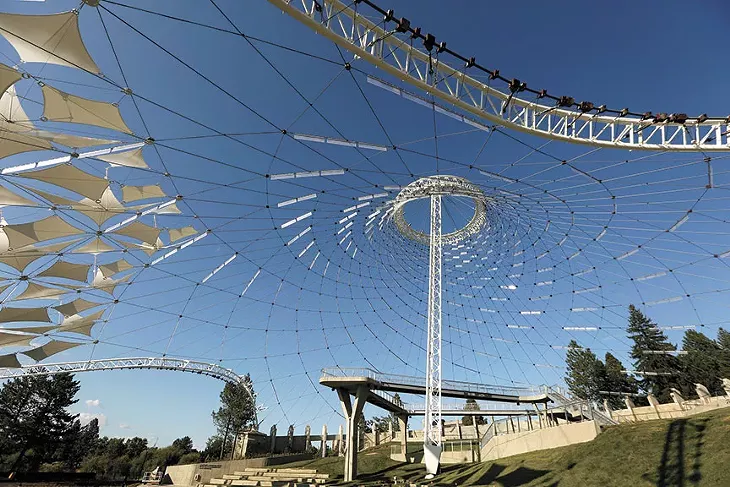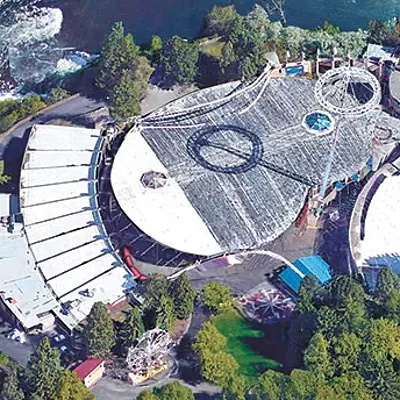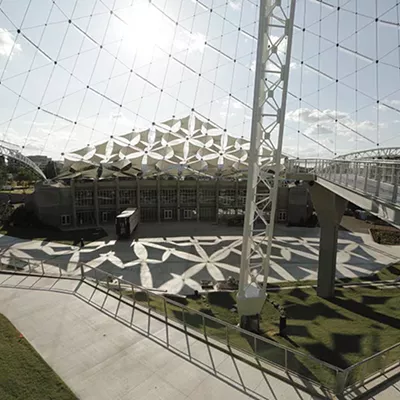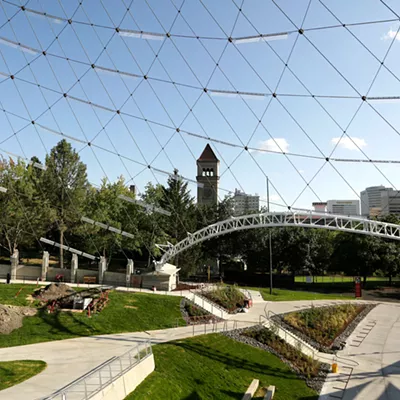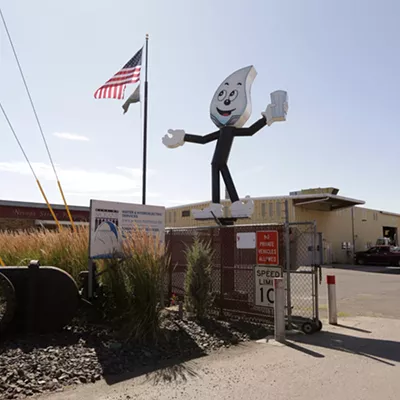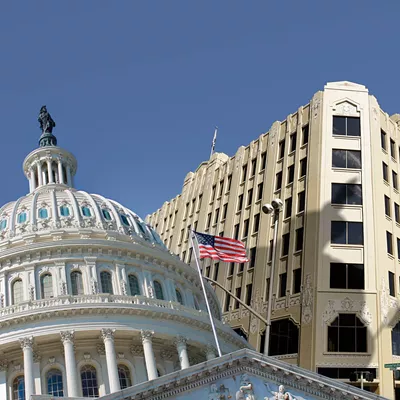David Condon says he wanted to be a mayor who changed the skyline of Spokane. After all, he was born in 1974, the same year that the World's Fair transformed an ugly railroad depot into the city's iconic Riverfront Park.
"I jokingly said I wanted to bring back Expo '74," Condon says. "I looked it up, and they're booked out until 2025. So I figured that wasn't going to work."
Just as the 1962 World's Fair gave the Seattle skyline its Space Needle, Expo '74 gave us the U.S. Pavilion, a giant exhibition tent that — once its heavy, white vinyl covering came off — left the spiderwebbed lattice of cabling that has become one of the region's most recognizable structures. Look at almost any image of Spokane — on a mug, a calendar or a "Spokane Doesn't Suck" T-shirt — and if it's not Riverfront Park's clock tower, it's the silhouette of the Pavilion. Or both.
And so as the transformed Pavilion officially opens up this week, Condon, in his last year in office, can truly say he's altered Spokane's skyline.
"Now that they've done the Pavilion with the lights, it's not only going to change the skyline for the city, it will be a gathering place for the community," he says.

For as much as the Pavilion has been a star of Spokane iconography, for decades the actual inside of it had become, frankly, a bit of an eyesore.
"It was a hole in the middle of the park," says former City Councilman Mike Allen, who'd served as council liaison to the Park Board for four years. Garrett Jones, interim director of the Parks Department, describes the old Pavilion as a "concrete jungle, dark and cold." It was cluttered with creaky amusement park rides during the summer and an ice rink during the winter, surrounded by industrial gray walls.
"The rides had decayed," Allen says. "It was a big open space, so sound reverberated around. You had this false roof inside of a roof."
The $64.3 million Riverfront Park bond, passed by voters in 2014, changed all that. In a way, it's done for the Pavilion what Expo '74 did for Riverfront Park — took an ugly mess of concrete and asphalt and replaced it with a sweeping greenspace.
A cascade of green terraces — a tad bit like Machu Picchu — rises up the eastern wall. Visitors can climb up a ramp to give them a view of the park they've never seen before.
"I think the park looks fantastic," Allen says.
The Pavilion upgrade, however, stands as a testament not only to the success of the Riverfront Park revitalization, but all the challenges it had to overcome.
THE UNCOVERING
After all, for all its beauty, the completed Pavilion represents a broken promise.
Before voters approved the bond, Condon and City Council President Ben Stuckart co-wrote an op-ed in the Spokesman-Review telling voters the project would create "a new cover for the Pavilion and strategic use of lighting or projected imagery." Renderings and advertisements during the bond campaign featured a vision of a covered Pavilion.
But today, the Pavilion remains uncovered. A covering, the Park Board determined, was too expensive and too infeasible. The old metal structure of the Pavilion couldn't support the weight.
In a Facebook post in 2017, former Park Board Chair Randy Cameron called the change "OUTRAGEOUS," arguing that it "was often said that it would rival the Sydney Opera House and now the board and parks director have amnesia?"
Skeptics like Allen worried that without a covering, the community would miss out on the opportunity to project images or videos on the side of the Pavilion, while Stuckart complained that without shading, events held in the Pavilion would bake in the summer heat.
"I sat through a dozen meetings talking about that," Stuckart says.
But there were downsides to covering the structure that would have gone beyond cost, Condon argued. You would lose the view of the rest of the park when you stepped into the Pavilion.
"It would feel like you're inside a big tent," Condon says, "You wouldn't be able to have the grass in there and the terraces."
And so the design team got creative, trying to figure out an innovative way to satisfy seemingly controversial goals. For shade, the design team stuck white, kite-shaped panels on the lower western section of the Pavilion cabling. During the hottest part of the summer day, the panels will cast shadows to cool the crowds. But during the cooler hours, the crowds will still be bathed in sunlight.
"It turned out really well," Stuckart says now.
The Park Board had demanded a "wow factor." And while it didn't get a covering that the community can project images onto, it got something even more unusual.
"I never in my wildest dreams would have thought of this technology that we're using for the lights," Condon says.
Rob Kuffel, a member of the NAC architectural team assigned to the project, got some automotive LEDs out of his garage and slapped them on the side of a Plexiglas panel. It was the earliest crude prototype. A secondary prototype wasn't quite as jury-rigged, but it remained clunky and unwieldy.
"The thing weighs 60 pounds, [the NAC team was] lugging it to meetings, and plugging it in," recalls Jones, the interim parks director.

Today, when you stand underneath the Pavilion and look up, the light blades spiral around the structure, almost giving an illusion of motion. In the daytime, it turns the steel structure from a utilitarian skeleton missing a tent covering into something closer to abstract art.
And at night?
The blades won't just light up. They'll dance. Every light can be controlled individually by computer — technicians can program a specific light with a specific motion and a specific color at a specific moment.
And so when the Cronkites play the grand opening of the Pavilion this Friday, the last song they'll play will be accompanied by the Pavilion structure lighting up in sync to the music. Think of it as Spokane's own version of a Pink Floyd laser light show.
"The first time when we were out there doing the testing, you see the entire promenade lined up with people with tripods and cameras," Jones says. "And you ask, 'Is this cool?' And they're like, 'Yeah. This is better than the Fourth of July.'"
THE TROUBLES
The fight over the Pavilion was hardly the only flare-up the Riverfront Park project has had to weather, of course. Originally, the entire rehab was supposed to be completed by the spring of 2018. But as challenges mounted, the anticipated completion date slid to 2019 to sometime in 2020.
"I underestimated how much expertise and what was needed to get going," says former Park Board Chair Chris Wright. "We didn't do anything for a year, and that was obvious to the public."
There was plenty to criticize: Former Park Board members like Cameron and Andy Dunau complained at times that the Parks Department did a lousy job of communicating with the public about the project's problems.
The decision to inspect the park's bridges — first recommended by the city's engineering department in May of 2013 — was delayed until five months after the bond passed. And the price tag that came back showed that repairing the bridges was much more expensive than anticipated.
As the years unfolded, the project got some surprise wins — it turned out the park wouldn't have to replace the big blue bridge after all — but also some surprise setbacks.
Start with the cursed Rotary Fountain. Scarcely a dozen years after opening, the Rotary Fountain had to be shut down and repaired at the cost of nearly $1 million.
And before the park's promenade opened this spring, the park announced that one of its pedestrian bridges — where visitors could feel the spray of the falls rise up and splash against their faces — would have to be closed for repairs. It was an expense that the bond wouldn't cover.
Meanwhile, community members successfully championed the resurrection of one of the "butterflies" sculptures featured at Expo '74. But other beloved pieces of the park were sacrificed. A few people fought to save the aging amusement park rides, like the creaking Ferris wheel, and the old IMAX theater, but ultimately, balance-sheet calculations beat nostalgia. The Ferris wheel was junked and the IMAX was demolished.
Other plans were altered. The project's plan originally called for an ice rink. But the Park Board ultimately went in a more ambitious direction, building a more expensive looping "ice ribbon," complete with a slightly downhill portion.
"It was the toughest project. It was the first one," says Wright. "I thought it turned out really well, and the winter usage is fantastic."
Sometimes the revitalization has meant casting an old local artifact in a new light. The Looff Carrousel, more than a century old, got a new rotunda and a boardwalk. The famous garbage-eating goat statue remained untouched, but Spokane Arts painted a nearby utility box with former Inlander art director Chris Bovey's "Spokane's Garbage Goat" design.
The project also has had to contend with nature itself, like the federally protected ospreys that built a nest on top of the Pavilion. And there are even more destructive critters.
"To what degree have beavers created challenges for the project?" the Inlander asks Condon.
Mayor Condon laughs at the absurdity of such a silly question.
"That's the curveball of the day," Condon says.
But then Jones, the interim parks director, jumps in to say that, well...

"On the north promenade, we had a beaver come and chop down one of the trees," Jones says. "We did have one incident on the North Bank where a beaver decided to take it and drag it. Didn't make it all the way to the river."
BUT WAIT, THERE'S MORE
The Pavilion opens this week, but the Riverfront Park project isn't done. There's still the North Bank, across the Spokane River. Today, it's a parking lot next to a fenced-in storage space filled with old park equipment. A year from now, it's scheduled to be turned into one of the biggest playgrounds in the region.
The playground will be almost a full acre — almost the size of 16 tennis courts — complete with a climbing structures, sandboxes and 30-foot tower with three slides. And the playground will all be themed around the Ice Age floods.
"We're looking at having a water feature that does spill over, that mimics the Missoula floods breaking free," Riverfront Park Director Jon Moog says.
Will there be wooly mammoth tusks? Of course, there will be wooly mammoth tusks.
The North Bank will also fulfill a long delayed promise: a skatepark.
When the city tore down downtown's troubled Under the Freeway skatepark in 2015, it promised to replace it. But years passed by, frustrating the local skater community. For now, the new skatepark will be only modestly sized, but if enough funds are raised, two bowls will be added, with a wall in the park's maintenance and operations building turned into a slanted wall ride.
Even with over $64 million in spending, there's a lot of dream projects for Riverfront Park that weren't built. The park rehab had to fit the budget, and not the other way around.
That's even true for some of Condon's ideas. Nearly eight years ago, Condon was sworn in at the base of the clock tower, the other recognizable symbol of Riverfront Park.
"I thought we should reopen the clock tower," Condon says. "They've done all the engineering for it, but we didn't have the money for it."
That upgrade of a Riverfront Park icon, however, may have to wait until the next mayor. ♦
WhHAT'S IN A NAME
You may have noticed that Spokane Parks and Recreation has taken to calling it "Riverfront Spokane" — it's right there on the park's new logo. That subtle name change is by design — and by vote of the Park Board. The reason being that there are many "Riverfront Parks" across America, but there's only one Riverfront Spokane. Don't worry, there's no right or wrong way to say it, and "Riverfront Park" still works just fine.
ABOUT THE AUTHOR
Daniel Walters has been writing for the Inlander since 2008. In that time, he's covered real estate scams, the Central City Line, the effort to fund the Sportsplex and the McEuen Park battle in Coeur d'Alene. He can be reached at 325-0634 ext. 263 or via email at danielw@inlander.com. His favorite Carrousel horse is the giraffe.




